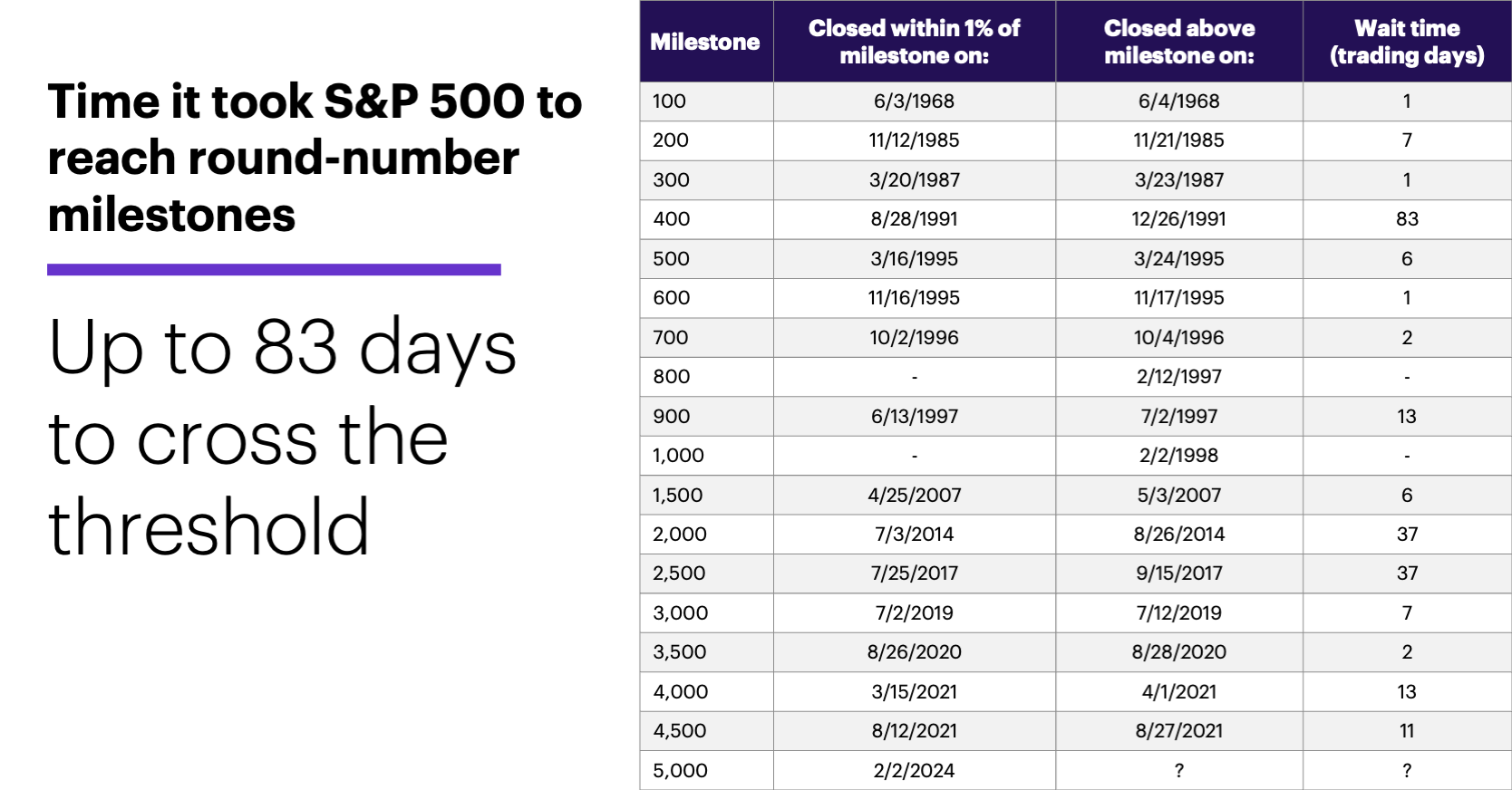S&P 5,000
- S&P 500 closed within 1% of 5,000 last Friday
- Index up nearly 20% from late-October lows
- Rallies sometimes followed other “round numbers”
Certain market milestones—oh, say, the S&P 500 (SPX) hitting a round-number price like 5,000 for the first time—make for good headlines. But do they really matter?
Their “importance” is arguably psychological. After all, is there a significant difference between the SPX closing at 5,000 or less than 1% below that level (4,958.61), as it did last Friday? Making that distinction is like saying there’s a meaningful difference between a 21.4% rally off the October lows and a 20.4% rally off those lows. Either way, it’s a significant move.
But it is educational to look at other times the SPX closed within 1% of a “round-number” price—which, for simplicity, we’ll define in 100-point increments from 100 to 1,000, and in increments of 500 (1,500, 2,000, etc.) above that. The following table shows the results dating back to 1968, when the SPX first closed above 100:1

Source: Power E*TRADE (For illustration purposes. Not a recommendation. Note: It is not possible to invest directly in an index.)
Considering the SPX had to rally such a small amount in each case—less than it gained on either Thursday or Friday last week—traders may be surprised to see how long the wait sometimes was. It took the index anywhere from one to 83 trading days (around four months) to close above a round-number milestone after initially closing within 1% of it. (In February 1997 and February 1998, the SPX jumped above 800 and 1,000, respectively, before closing within 1% of either threshold.) Even so, in most cases it took less than two weeks for the index to accomplish the task.
The SPX’s performance after climbing above a round-number threshold may also be something of an eye opener. The table below shows the index’s returns five, 10, 20, 60, and 120 trading days (i.e., one week to roughly six months) after hitting the round-number milestones from the first table. More often than not, the SPX was stronger than average, at least for a while:

Source: Power E*TRADE (For illustration purposes. Not a recommendation. Note: It is not possible to invest directly in an index.)
For example, 20 trading days after crossing these thresholds the SPX was higher in 11 of 17 cases (65% of the time), with a median return of 1.8%. Those numbers are a little better than the SPX’s 1% median return and 60% positivity rate for all 20-day periods since March 1968. At the 60-day mark, the SPX was higher 88% of the time (15 of 17 instances), with a median return of 3.8%—again, an improvement on the index’s benchmark 65% positivity rate and 2.4% median return for all 60-day periods. After 120 trading days, the SPX was higher 88% of the time, with a median return of 8.7%, better than the 68% and 4.4% benchmarks.
No one knows if these tendencies will play out this time around, and there are plenty of caveats to consider with this data—beyond the relative handful of historical examples. First, what the market did leading up to these milestones can’t be ignored. As of last Friday, the SPX’s rally off the October 27 low was its largest 67-day gain since the market was rebounding off its pandemic lows in 2020. In other words, if the SPX closes above 5,000 in, say, the next two to three weeks, it will be doing so on the heels of a very strong short-term rally.
That would be quite different from the situation on July 2, 2019, when the SPX closed less than 1% below 3,000 after rallying only 5.6% over the preceding 67 trading days, or on July 3, 2014, when it closed less than 1% below 2,000 after gaining only 6% over the previous 67 trading days.
Then there are the differences in macro conditions to consider—e.g., today’s interest rate environment (and expectations about that environment going forward), and the fact that we’re in the middle of a presidential election.
But if you’re keeping track, we’re now three days into “5,000 watch.” It should be interesting.
Market Mover Update: As of Tuesday, the Ball (BALL) March $52.50-$65 was trading around $0.55, a $125,000 decline in the position from last Thursday described in “Connecting with volatility.”
Today’s numbers include (all times ET): Mortgage Applications (7 a.m.), International Trade in Goods and Services (8:30 a.m.), EIA Petroleum Status Report (10:30 a.m.), Consumer Credit (3 p.m.).
Today’s earnings include: Roblox (RBLX), Uber (UBER), Digital Turbine (APPS), Disney (DIS), Mattel (MAT), Netgear (NTGR), O’Reilly Automotive (ORLY), Paycom Software (PAYC), PayPal (PYPL), Wynn Resorts (WYNN).
Click here to log on to your account or learn more about E*TRADE's trading platforms, or follow the Company on Twitter, @ETRADE, for useful trading and investing insights.
1 All figures reflect S&P 500 (SPX) daily price data, 12/30/67-2/6/24. Supporting document available upon request.